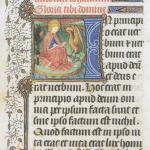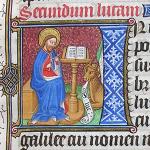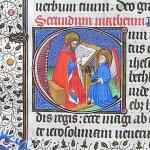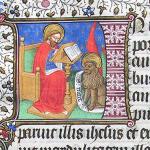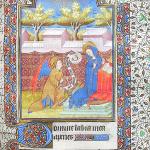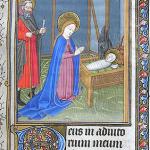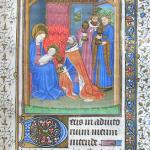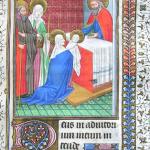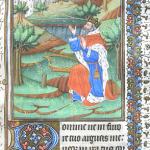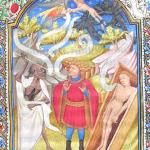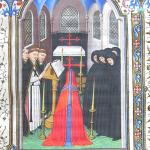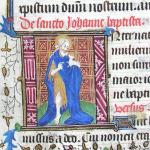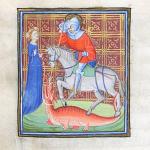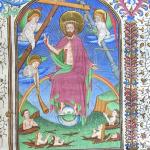HORAE. (LADY MARGARET)
Vellum, 8.25 x 6, ff. 1 + 179, 15 lines to a page. 15th cent.: black ink, Gothic hand with a slight slope.
Modern binding.
Presented in October, 1902, by Alexander Peckover, now Lord Peckover of Wisbech.
Formerly in the Fountaine Collection (Narford Hall, Norfolk): sold on 6 July 1894.
On the flyleaf is: No. 74. On f. 1 in red: No. 3.
Collation : 1 flyleaf, 16 26 | 38 48 (8 canc.) 58 68 (wants 4, 5) 78 88 (wants 8) 98 108 (wants 5) 118 (wants 4) 1210 (wants 2, 6) | 138 – 228 238 (wants 2 and 7 ?) 248 (wants 7, 8).
Contents:
Kalendar in French, in blue and gold: not full . . . f. 1
Sequences of the Gospels . . . . . 13
Obsecro te, 19b. O intemerata, 23.
Hours of the Virgin. Use of Coutances . . . 28
(Capit. in Lauds, Ab initio. Ant. O gloriosa.)
The services for Lauds, Tierce, Vespers, Compline have lost their
beginnings.
Hours of the Cross (beginning gone) . . . . 81
Hours of the Holy Ghost „ . . . . 84
Penitential Psalms, and Litany . . . . 88
Officium (Mass) beate marie virginis . . . . 112
Missa de S. Spiritu, 114b. Pro defunctis, 117.
Office of the Dead. Dilexi, 120. Verba mea, 128.
Memoria: The Trinity, SS. Michael, John Baptist, Peter and Paul,
Laurence, Nicholas, George (picture only) . . . 165
The xv Joys in French (beginning gone) . . . 169
ff. 173, 4 blank.
The Seven Requests in French, beginning Dame quicunques veult
estre bien conseilliez; ending, unfinished, in Sainte vraie crois
aouree . . . . . . . 175
178b, 179 blank.
On 179b (xvi – xvii): Iste liber pertinet Francisco Belo ex dono
(blank).
On f. 12b (end of the Kalendar) in the lower margin in pale ink is written the inscription which gives to the book its principal interest:
my good lady Shyrley pray for
me that gevythe yow thys booke
y hertely pray yow | Margaret |
modyr to the kynge.
Lady Anne Shirley was wife of Sir Ralph Shirley and daughter of Sir Henry Vernon of Haddon.
Though the book thus undoubtedly belonged to Lady Margaret, it cannot have been written for her: it is of too early a date for that. It belongs, moreover, to the diocese of Coutances, and has no English additions.
In the Kalendar, which, as noted, is entirely in blue and gold and has very few feasts marked, the most noteworthy entries seem to be the following (italicized entries are in gold in the MS.):
|
Jan. Feb. Ap. May JuneJuly Aug. Sept. Oct. |
22. 19. 3. 10. 11. 16.
|
Hylaire, Mor, Anthonie, Iulien. Bride. 16. Juliane. Oportune. 28. Vital. Yues. 26. Augustin. 31. Pernelle. Marcel. 16. cir et Julitte. 19. gerues et prothes. les sepst freres. 18. cler. 26. Anne. 29. Marthe. Taurin. 25. Loys. 30. Fiacre. Flessel. 21. Lo. 30. Lez reliques de coustances. Francoys, Denis. 16. Michiel. 20. Les xi mille uierges. |
In the Litany: Martyrs end with Julian, Blasius, Gervase, Prothase, Saturninus, Anthoninus, Clarus. Confessors with Laudus, Thaurinus, Benedict. Virgins include Genovefa, Radegundis, Brigida.
The decoration is of very fine quality: drawing very crisp and clear: colouring very bright and delicate. Borders are of line and leaf work as a basis, with leaves in gold and insertions of conventional foliage, and strawberries, etc., in colour. There are partial borders on all pages which contain a small picture or the beginning of a psalm, prayer, or the like, and full borders on the pages which have large pictures.
The following pictures remain:
Sequences of the Gospels. f. 13. 1. Initial. John, in dark red, on island writing: devil on L. about to steal his inkhorn: eagle, nimbed, on R. Red ground with gold flourishing.
f.15r. 2. Luke, in blue, seated trimming his pen, book on desk. Ox with scroll, S. Luc. Ground as no. 1.
f.16v. 3. Matthew writing, in scarlet robe over blue. Angel in blue kneels holding ink-bottle and pen-case. Blue and gold ground.
f.18v. 4. Mark, in scarlet, writing. Lion with scroll, S. Marc. Blue ground, starred.
Hours of the Virgin. f. 28. 5. Matins. The Annunciation. The background is a low wall with massive battlements hung with crimson arras with gold pattern. The Virgin in blue kneeling on R. and turning to the angel: the Dove, very small, seen at the top of her nimbus. Gabriel, in gold robe, with scroll, aue-tecum. Three pale yellow-green trees, and hills, seen over the wall. Above in the sky the Father, half-length.
Full border, with a fine frame to the picture of gold with red and blue foliage on it.
6. Prime. f. 51. The Stable. The Child, swaddled, in wooden crib on R. The ox and ass’s heads seen over it. The Virgin in blue over lake kneels at His feet. Joseph in rough dark cloak over scarlet stands behind her holding a lighted candle. Straws lie about the floor. The stable is interestingly drawn.
7. Sext. f. 61. The Adoration of the Magi. The Virgin with the swaddled Child seated on L. in the stable. All the kings are in long robes with ermine or fur linings. As usual, one kneels bare-headed and offers a cup full of gold. The other two stand, in their crowns, holding their offerings.
The Star shines through a hole in the stable roof. The stable has been partly hung with arras.
8. None. f. 65. Presentation. The Virgin in blue with white kerchief kneels holding the swaddled Child. Joseph and the maid with the doves, both nimbed, on L. Symeon in a scarlet robe and darker red head-dress on R. of the altar.
9. Penitential Psalms. f. 87. David in gold robe lined with ermine over blue, crowned, kneels facing L. in landscape: his harp by him. God in the sky, half-length. Castle and windmill on hill in the distance.
10. Office of the Dead. Dilexi. f. 119. In C. foreground a young man in scarlet tunic lined with fur, and blue hose, etc., his hair (or head-dress) spreading very wide, in the form of gold leaves. He looks to L., where Death, a skeleton-corpse in a shroud holding two darts, is smiting him on the breast with one of them. On R. lies his nude corpse in a coffin.
Above, his soul, nude, in air. Two angels in silver take it by the arms: one is armed with a long cross-spear. Two black devils seize the legs of the soul.
The ground and trees are yellow-green.
The figures of Death, the youth, the corpse, the angels, demons and soul have all blank scrolls.1
Another Coutances Horae (Fitzwilliam MS. 61) has a similar picture for the Office of the Dead.
11. Verba mea. f. 127. Funeral in choir. Mourners in black on R. Coffin with scarlet pall and blue and gold cross in C. Clergy in black copes on L. The altar has black riddles and a black frontal and dossal, each bearing a red cross with fleurs-de-lys terminations.
12. Memoriae. f. 165. The text. St John Baptist in blue over gold hair robe holding lamb. Red ground with gold lines.
13. f. 167. St George in scarlet tunic and plate-armour on white horse on the back of the dragon. The Princess on L. holds a cord tied to its neck. Ground as no. 12.
No text has been written: the leaf has only this small square picture.
14. f. 174. Seven Requests. Large. The Judge, crowned with thorns and showing His wounds, on the rainbow. The globe with trees, land and water under His feet. One angel on L. blows trumpet. Two above on R. and L. hold cross with title, and column with scourge. Below, six people rise from graves in the green grass.
Lord Peckover's priced catalogue is in St John's College Library.
Artist of miniatures is 'Fastolfe Master', as in Bodleian Library Laud misc. 570.
J. J. G. Alexander and O. Pächt, Illuminated Manuscripts in the Bodleian Library Vol. 1 (Oxford, 1966), p. vii.
Described in British Library, Additional MS 22931, ff. 11–13; the description includes a facsimile (probably a tracing) of Lady Margaret’s inscription. The volume as a whole is a descriptive catalogue of the manuscript collection of Sir Andrew Fountaine (1676–1753) of Narford Hall, Norfolk, by a local antiquary, Sir John Fenn (1739–94), the first editor of the Paston Letters.
Exhibited at Treasures of Cambridge (Worshipful Company of Goldsmiths, London, 1959).
Exhibited at A Thousand Years of French Books (National Book League, London, 1948). Catalogue no. 8.
Exhibited (f.61r) at the Fitzwilliam Museum, Cambridge, from 26 July to 11 December 2005. See the exhibition catalogue: P. Binski and S. Panayotova (eds.), The Cambridge Illuminations: Ten Centuries of Book Production in the Medieval West (London: Harvey Miller, 2005) no. 89.
1. In the Dunois Horae (H. Y. Thompson, Fifty MSS. I, p. 56, no. 65) is a somewhat similar picture, where the scrolls have their inscriptions. The corpse says: Circumdederunt me dolores mortis, etc. The demon: Lubricus fuit. The angels: Penituit et elemosinam dedit. Sinite illam. iustum et impium iudicabit dominus.
